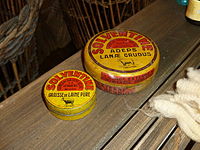
Photo from wikipedia
A simple, rapid, and sensitive method was developed for simultaneous determination of 103 multiclass pesticides in edible oils. A new strategy of sample preparation involving a spontaneous emulsification followed by… Click to show full abstract
A simple, rapid, and sensitive method was developed for simultaneous determination of 103 multiclass pesticides in edible oils. A new strategy of sample preparation involving a spontaneous emulsification followed by membrane-based demulsification was proposed. The developed strategy was compared with other reputed clean-up procedures and found to improve the removal efficiency of matrix interferences without a significant loss of pesticides. GC-MS/MS was used to evaluate the proposed treatment methodologies. Recovery studies were performed at 10, 20, and 50 μg/kg levels in soybean oil, olive oil, and rapeseed oil. Throughout the validations, 70-120% overall recoveries were achieved with RSDs < 10% for the majority of pesticides. Limits of quantification ranged from 10 to 50 μg/kg (10 μg/kg for over 92% pesticides), less than the regulatory MRLs. Twenty-two of 30 market samples were found to contain one or several detectable pesticide residues ranged from < 1 to 105.9 μg/kg.
Journal Title: Food chemistry
Year Published: 2022
Link to full text (if available)
Share on Social Media: Sign Up to like & get
recommendations!